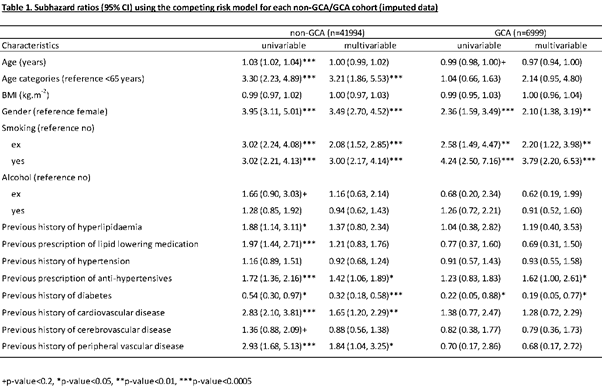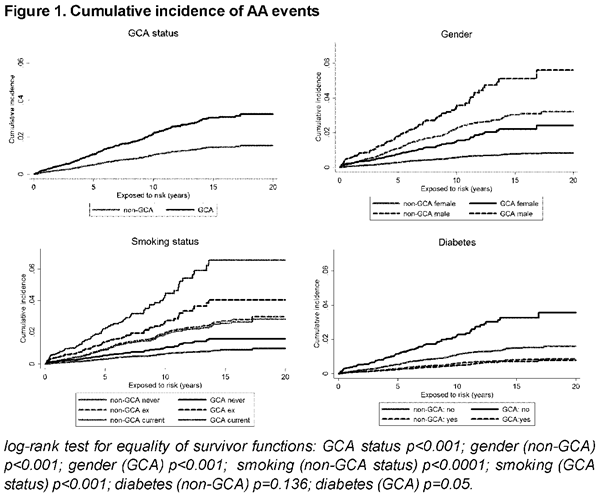Background/Purpose: To evaluate the risk of aortic aneurysm in patients with giant cell arteritis (GCA) when compared with age, gender and location matched controls from the general population.
Methods: Parallel cohort study. General Practice Research Database (GPRD). 6999 men and women with giant cell arteritis (GCA). Non-GCA patients matched on a 6:1 ratio on the following three parameters: same GP practice, year of birth (+/- 3 years) and gender. A competing risk model using aortic aneurysm as the primary outcome and death as the competing risk, was used to determine the relative risk (subhazard ratio) between non-GCA and GCA subjects, after adjustment for cardiovascular risk factors.
Results: Comparing the GCA cohort with the non-GCA cohort, using a multivariable model with adjustment for BMI, smoking, alcohol, hyperlipidaemia, lipid lowering medication, hypertension, anti-hypertensives, diabetes, cardiovascular disease, cerebrovascular disease and peripheral vascular disease; the subhazard ratio for aortic aneurysm (95% CI) was 1.92 (1.52 to 2.41). Significant predictors of aortic aneurysm were as follows:being an ex-smoker 2.64 (2.03 to 3.43), current smoker 3.37 (2.61 to 4.37), previous prescription of anti-hypertensives 1.57 (1.23 to 2.01), previous history of diabetes 0.32 (0.19 to 0.56) and previous history of cardiovascular disease 1.98 (1.50 to 2.63). In a multivariable model of the GCA cohort alone, male gender 2.10 (1.38 to 3.19), smoking 3.79 (2.20 to 6.53), and diabetes 0.19 (0.05 to 0.77) were significant predictors of aortic aneurysm.
Conclusion: This study demonstrates a two-fold increased risk of aortic aneurysm in patients with GCA. Other risk factors for aortic aneurysm, including male gender, age, and smoking, are important in patients with GCA and the general population. The message for clinicians and policymakers is therefore that the diagnosis of GCA should be considered within the context of the range of risk factors for aortic aneurysm, rather than acting as a prompt for a specific screening programme. This study also demonstrates for the first time the protective effect of diabetes in the development of aortic aneurysms in patients with GCA.
Disclosure:
J. Robson,
GlaxoSmithKline,
5,
Nordic Pharma,
8;
A. Kiran,
None;
J. Maskell,
None;
A. Hutchings,
None;
N. K. Arden,
None;
B. Dasgupta,
Napp,Roche,
2;
W. Hamilton,
None;
A. Emin,
None;
D. Culliford,
None;
R. A. Luqmani,
None.
« Back to 2013 ACR/ARHP Annual Meeting
ACR Meeting Abstracts - https://acrabstracts.org/abstract/the-relative-risk-of-aortic-aneurysm-in-patients-with-giant-cell-arteritis-compared-with-the-general-population/


